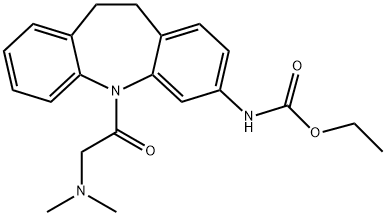Ethyl carbamate , 99% , 51-79-6
Synonym(s):
Carbamic acid ethyl ester;Ethyl carbamate;Ethylurethane
CAS NO.:51-79-6
Empirical Formula: C3H7NO2
Molecular Weight: 89.09
MDL number: MFCD00007966
EINECS: 200-123-1
| Pack Size | Price | Stock | Quantity |
| 25G | RMB42.40 | In Stock |
|
| 100G | RMB86.40 | In Stock |
|
| 250g | RMB159.20 | In Stock |
|
| 500G | RMB237.60 | In Stock |
|
| 2.5kg | RMB911.20 | In Stock |
|
| others | Enquire |
PRODUCT Properties
| Melting point: | 48-50 °C(lit.) |
| Boiling point: | 182-184 °C(lit.) |
| Density | 1.10 |
| vapor density | 3.07 (vs air) |
| vapor pressure | 10 mm Hg ( 77.8 °C) |
| refractive index | 1.4144 |
| Flash point: | 198 °F |
| storage temp. | Sealed in dry,Room Temperature |
| solubility | slightly soluble |
| form | Crystals or Crystalline Powder |
| pka | 13.58±0.50(Predicted) |
| color | White |
| PH | pH(50g/l, 25℃) : 5.0~7.0 |
| Water Solubility | slightly soluble |
| Merck | 14,9874 |
| BRN | 635810 |
| Dielectric constant | 14.2(50℃) |
| Stability: | Stable. Incompatible with strong acids, strong bases, strong oxidizing agents. |
| LogP | -0.150 |
| CAS DataBase Reference | 51-79-6(CAS DataBase Reference) |
| IARC | 2A (Vol. 7, Sup 7, 96) 2010 |
| NIST Chemistry Reference | Urethane(51-79-6) |
| EPA Substance Registry System | Urethane (51-79-6) |
Description and Uses
Ethyl carbamate occurs as colourless or white columnar crystals or granular powder. It is very soluble in water. With heat, ethyl carbamate undergoes decomposition and emits toxic fumes of carbon monoxide, carbon dioxide, and nitrogen oxides. Ethyl carbamate is used as an intermediate in the synthesis of a number of chemical products, for example, pharmaceuticals, in biochemical research and medicine, and as a solubiliser and co-solvent for pesticides and fumigants. Prior to World War II, ethyl carbamate saw relatively heavy use in the treatment of multiple myeloma before it was found to be toxic, carcinogenic, and largely ineffective. However, due to U.S. FDA regulations, ethyl carbamate has been withdrawn from pharmaceutical use. However, small quantities of ethyl carbamate are also used in laboratories as an anaesthetic for animals.
The primary use of urethane has been as a chemical intermediate in preparation of amino resins (IARC 1974). The process involves a reaction with formaldehyde to give hydroxymethyl derivatives that are used as cross-linking agents in permanent-press textile treatments designed to impart wash-and-wear properties to fabrics. Urethane isalso used as a solubilizer and co-solvent in the manufacture of pesticides, fumigants, and cosmetics, as an intermediate in the manufacture of pharmaceuticals, and in biochemical research (HSDB 2009). Urethane was formerly used as an active ingredient in drugs prescribed for the treatment of neoplastic diseases, as a sclerosing solution for varicose veins, as a hypnotic, and as a topical bactericide. It is also used in veterinary medicine as an anesthetic (IARC 1974). Urethane is produced naturally during many fermentation processes(Zimmerli and Schlatter 1991).
Safety
| Symbol(GHS) |   GHS07,GHS08 |
| Signal word | Danger |
| Hazard statements | H302-H350 |
| Precautionary statements | P201-P301+P312+P330-P308+P313 |
| Hazard Codes | T |
| Risk Statements | 45-22 |
| Safety Statements | 53-45-99 |
| RIDADR | UN 3077 9 / PGIII |
| WGK Germany | 3 |
| RTECS | FA8400000 |
| TSCA | Yes |
| HS Code | 29241990 |
| Hazardous Substances Data | 51-79-6(Hazardous Substances Data) |
| Toxicity | MLD i.p. in mice: 2.1-2.2 g/kg (Franklin) |





